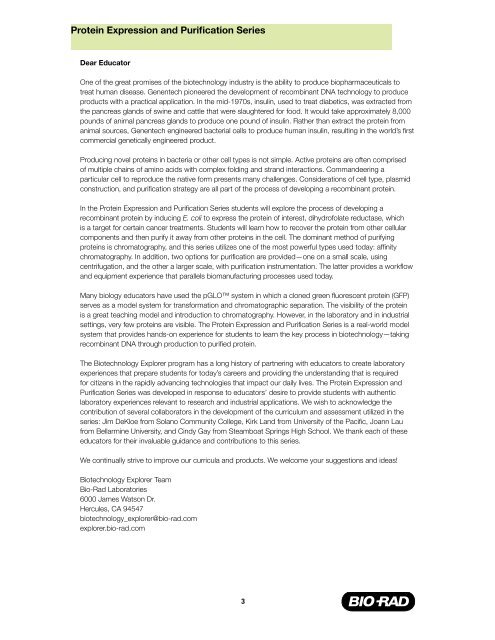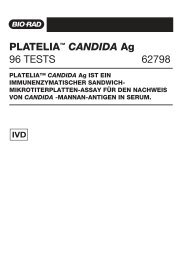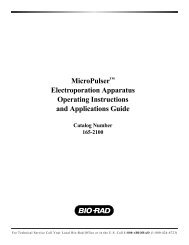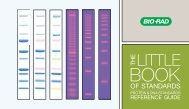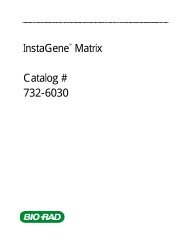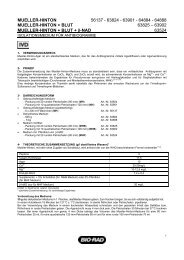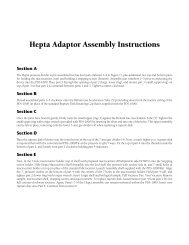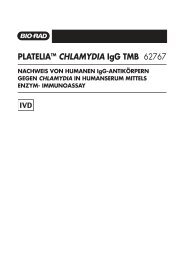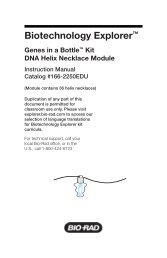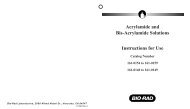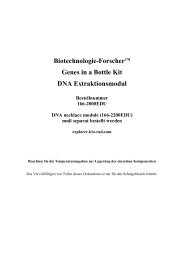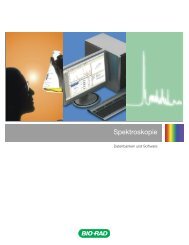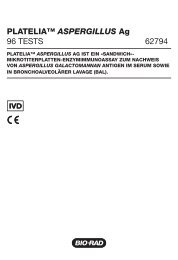Protein Expression and Purification Series - Bio-Rad
Protein Expression and Purification Series - Bio-Rad
Protein Expression and Purification Series - Bio-Rad
You also want an ePaper? Increase the reach of your titles
YUMPU automatically turns print PDFs into web optimized ePapers that Google loves.
<strong>Protein</strong> <strong>Expression</strong> <strong>and</strong> <strong>Purification</strong> <strong>Series</strong><br />
Dear Educator<br />
One of the great promises of the biotechnology industry is the ability to produce biopharmaceuticals to<br />
treat human disease. Genentech pioneered the development of recombinant DNA technology to produce<br />
products with a practical application. In the mid-1970s, insulin, used to treat diabetics, was extracted from<br />
the pancreas gl<strong>and</strong>s of swine <strong>and</strong> cattle that were slaughtered for food. It would take approximately 8,000<br />
pounds of animal pancreas gl<strong>and</strong>s to produce one pound of insulin. Rather than extract the protein from<br />
animal sources, Genentech engineered bacterial cells to produce human insulin, resulting in the world’s first<br />
commercial genetically engineered product.<br />
Producing novel proteins in bacteria or other cell types is not simple. Active proteins are often comprised<br />
of multiple chains of amino acids with complex folding <strong>and</strong> str<strong>and</strong> interactions. Comm<strong>and</strong>eering a<br />
particular cell to reproduce the native form presents many challenges. Considerations of cell type, plasmid<br />
construction, <strong>and</strong> purification strategy are all part of the process of developing a recombinant protein.<br />
In the <strong>Protein</strong> <strong>Expression</strong> <strong>and</strong> <strong>Purification</strong> <strong>Series</strong> students will explore the process of developing a<br />
recombinant protein by inducing E. coli to express the protein of interest, dihydrofolate reductase, which<br />
is a target for certain cancer treatments. Students will learn how to recover the protein from other cellular<br />
components <strong>and</strong> then purify it away from other proteins in the cell. The dominant method of purifying<br />
proteins is chromatography, <strong>and</strong> this series utilizes one of the most powerful types used today: affinity<br />
chromatography. In addition, two options for purification are provided—one on a small scale, using<br />
centrifugation, <strong>and</strong> the other a larger scale, with purification instrumentation. The latter provides a workflow<br />
<strong>and</strong> equipment experience that parallels biomanufacturing processes used today.<br />
Many biology educators have used the pGLO system in which a cloned green fluorescent protein (GFP)<br />
serves as a model system for transformation <strong>and</strong> chromatographic separation. The visibility of the protein<br />
is a great teaching model <strong>and</strong> introduction to chromatography. However, in the laboratory <strong>and</strong> in industrial<br />
settings, very few proteins are visible. The <strong>Protein</strong> <strong>Expression</strong> <strong>and</strong> <strong>Purification</strong> <strong>Series</strong> is a real-world model<br />
system that provides h<strong>and</strong>s-on experience for students to learn the key process in biotechnology—taking<br />
recombinant DNA through production to purified protein.<br />
The <strong>Bio</strong>technology Explorer program has a long history of partnering with educators to create laboratory<br />
experiences that prepare students for today’s careers <strong>and</strong> providing the underst<strong>and</strong>ing that is required<br />
for citizens in the rapidly advancing technologies that impact our daily lives. The <strong>Protein</strong> <strong>Expression</strong> <strong>and</strong><br />
<strong>Purification</strong> <strong>Series</strong> was developed in response to educators’ desire to provide students with authentic<br />
laboratory experiences relevant to research <strong>and</strong> industrial applications. We wish to acknowledge the<br />
contribution of several collaborators in the development of the curriculum <strong>and</strong> assessment utilized in the<br />
series: Jim DeKloe from Solano Community College, Kirk L<strong>and</strong> from University of the Pacific, Joann Lau<br />
from Bellarmine University, <strong>and</strong> Cindy Gay from Steamboat Springs High School. We thank each of these<br />
educators for their invaluable guidance <strong>and</strong> contributions to this series.<br />
We continually strive to improve our curricula <strong>and</strong> products. We welcome your suggestions <strong>and</strong> ideas!<br />
<strong>Bio</strong>technology Explorer Team<br />
<strong>Bio</strong>-<strong>Rad</strong> Laboratories<br />
6000 James Watson Dr.<br />
Hercules, CA 94547<br />
biotechnology_explorer@bio-rad.com<br />
explorer.bio-rad.com<br />
3


